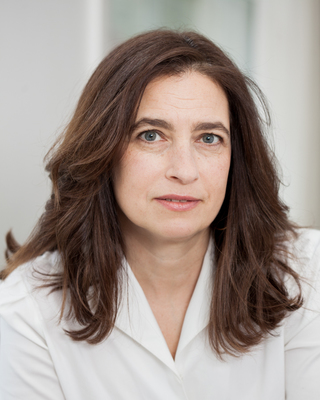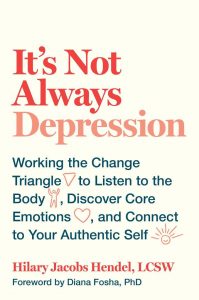Hendel ’85: It’s Not Always Depression Offers Guidance on Emotional Health


Hilary Jacobs Hendel ’85, P’18, a licensed psychoanalyst and certified Accelerated Experiential Dynamic Psychotherapy (AEDP) therapist and supervisor, is the author of It’s Not Always Depression (Random House and Penguin UK, 2018). She’ll be speaking at Wesleyan RJ Julia Bookstore, at 7 p.m. on March 1, about a psychotherapeutic tool she calls the Change Triangle, a guide to carry people from a place of disconnection back to their true self. It’s a step-by-step process to work with emotions to minimize stress and move toward authentic living. Through moving, persuasive stories of working the Change Triangle with her own patients, Hendel teaches us how to apply these principles to our everyday lives.
In this Q&A, she discusses the book:
Q: Your book is titled “It’s Not Always Depression”—then what is it?
HJH: It’s the effect that adverse life experiences have on us.
Traumas, adversity or just feeling alone or different from others—poor, gay, transgender, from another country, disabled—can overwhelm us and evoke emotions that we can’t process. For instance, if we feel anger about our difficult experiences, but that emotion is too much to bear, we block it and turn it inward, so we feel it as depression or anxiety.
Learning to name, listen to and experience our emotions heals the brain and mind. When we learn to tolerate our feelings and let them flow the way nature intended, we recover. It’s Not Always Depression shows people what that looks like and how to do that, either on their own, in partnership, groups, or with a therapist.
Q: What is this “Change Triangle” you mention?
HJH: It’s a simple diagram I use to teach people the relationship between core emotions (the bottom point of the triangle: anger, sadness, fear, joy, excitement, disgust, sexual excitement), inhibitory emotions (on the upper right point: anxiety, shame, guilt) and the defenses (on the upper left point: what we do to avoid the emotions). Core emotions are so important to understand and work with because when they are consistently thwarted with inhibitory emotions like guilt, this puts stress on the mind and body and leads to symptoms like depression. But when we can let our emotions flow and use them the way nature intended, our body and our nervous system return to a calm and balanced state and we feel authentic, connected and calm.
inhibitory emotions like guilt, this puts stress on the mind and body and leads to symptoms like depression. But when we can let our emotions flow and use them the way nature intended, our body and our nervous system return to a calm and balanced state and we feel authentic, connected and calm.
Q: When did you decide to write the book?
HJH: I was asked to write a book after The New York Times article on shame and depression went viral. “So what would you like to write about?” my literary agent asked me. I remembered the moment in my professional training when I first saw the triangle, called the “triangle of conflict” (David Malan wrote about it in the 1970s for therapists learning short-term dynamic psychotherapy). I had thought to myself, Everybody should know about this. I was already sharing it with my patients, family, colleagues and friends, so this was the perfect opportunity to give it a wider audience. It is outrageous that we get no education on emotions in our society when we need it so much.
Q: Any top-three takeaways from the book you’d like your readers to have?
HJH: Yes!
1) Everyone benefits from an education in emotions. Understanding how emotions move in the body and mind make them less mysterious and scary, especially at times when they are big and painful.
2) Emotions are physical responses that must be experienced to be processed to gain relief. We cannot think our way through an emotion; we must become comfortable with how it feels in our bodies.
3) Blocked emotions cause stress on the mind and body. This stress leads to symptoms, such as depression, anxiety, eating disorders, self-harm, addictions, personality disorders and more. In AEDP we don’t judge symptoms “bad.” We understand symptoms as having meaning. And defenses are maneuvers the mind makes to cope under difficult circumstances. I tell patients, “Your symptoms will abate when you have better ways to cope—like being with your true feelings.” The Change Triangle is a map back to health, showing how we can move from symptoms to peace of mind. The book will give you a complete sense of how to use the Change Triangle in your daily life.
Q: What do you enjoy most about being an AEDP therapist?
HJH: Helping people connect with their emotions so they can feel their authentic self—and seeing the relief, confidence, calm, clarity and peace of mind it gives them. And, knowing I am affecting future generations and the world for the better when people become emotionally competent. I am so gratified making emotion education accessible to others. It was life-changing information for me.
Q: Did any undergraduate experience at Wesleyan lay the groundwork for this career?
HJH: Professor of Psychology Bob Steele taught me to think critically, and I talk about that in the beginning of the book [see excerpt below]. Now, when I see something that makes sense to me, even though it goes against mainstream ideas (like cognitive behavioral therapy vs. AEDP), I stay open to it and learn everything I can until I draw a conclusion based on practice, research and intuition.
As I wrote in my book: “In college, I signed up for a course called Contemporary Psychoanalysis (Bob Steele’s class). Much to my chagrin, I realized that in fact it was an anti-Freudian course in feminism. For the first half of the semester, I sat righteously in the small seminar, me against ten radical feminists. Confident in my position, I argued fervently about why Freud was brilliant and his theories valid. After about five classes, I realized that my arguments were falling on deaf ears. In fact, my classmates had brought up some solid counterarguments and research that I found incredibly persuasive. The thought occurred to me that maybe I could learn something if I wasn’t so busy arguing.”
Sign up for Hilary’s blog and access free resources on emotions.

